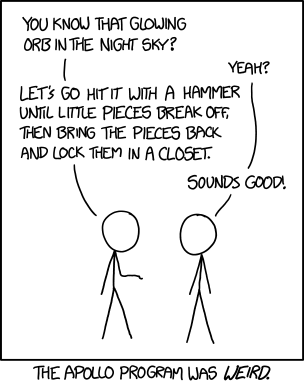An interesting article over at Slate that raises similar concerns to mine:
If we send heterosexual astronauts, of different sexes and of reproductive age, on extended space missions, then the possibility of pregnancy looms. To ward that off, could it be ethical to demand sterilization for any potentially fertile astronauts in a mixed-sex crew? Radiation exposure may eventually take care of the issue by causing infertility, but some pregnancies could happen before infertility occurs. Is conception even possible in the zero-gravity of space, or in the low-gravity, high-radiation habitats on Mars? If so, would a fetus develop normally?
We don’t know, since it would seem patently unethical to even conduct these sorts of experiments today in space or anywhere else, at least with human subjects. Again, the physical and psychological dangers of procreating and living outside of Earth can seem inhumane, especially for involuntary subjects (the children). Yet many plans for space exploration already take it as a foregone conclusion that humans will reproduce in space. For some, it’s a crucial part of the business plan, as in the case of Mars One’s goal of moving toward a “permanent human settlement.”
As I noted:
What I would suggest to the Mars One people, though, is given that they’re planning to spend billions on this project, and the long-term goal is to have true human settlement of the planet, which necessarily involves offspring of the settlers, they devote a modest amount of their budget funding research that NASA has completely neglected for decades, but that others have privately proposed, to establish a variable-gravity laboratory in orbit where we can start to understand these issues. The fact that NASA (or Congress) have never given such research any priority whatsoever is eloquent testimony to how unimportant both consider the goal of spreading humanity into the solar system. But until we do, young people who want to go off to barren (at least initially) worlds will have to continue to face the prospect of remaining barren themselves.
Space really isn’t important, politically. Just “space” jobs.
[Update a few minutes later]
Meanwhile, Kate Greene says that economics would dictate that a Mars mission consist of all women.
Here’s my problem with that. While of course mass is an important consideration, it isn’t the only one. I would argue that any Mars mission would have to be based on an affordable mission concept, and that if it is, mass won’t matter that much, and if it isn’t, no one will go. Beyond that, I think there’s a flaw in the logic here, or at least insufficient information:
Week in and week out, the three female crew members expended less than half the calories of the three male crew members. Less than half! We were all exercising roughly the same amount—at least 45 minutes a day for five consecutive days a week—but our metabolic furnaces were calibrated in radically different ways.
During one week, the most metabolically active male burned an average of 3,450 calories per day, while the least metabolically active female expended 1,475 calories per day. It was rare for a woman on crew to burn 2,000 calories in a day and common for male crew members to exceed 3,000.
We were only allowed to exit the habitat if we wore mock spacesuits. So many Martian hassles, so little glory.
The data certainly fit with my other observations. At mealtime, the women took smaller portions than the men, who often went back for seconds. One crew member complained how hard it was to maintain his weight, despite all the calories he was taking in.
She doesn’t say, but is it possible that maybe the men were doing more physical work? If so, it might be that if the women had to do all of the heavy lifting, their calorie consumption would increase too. In any event, if you just want to send people to Mars for the sake of sending people to Mars, a female crew would be fine, but if you want to settle the planet, there would be a problem…
[Tuesday-morning update]
There seems to be a lot of off-topic whining in comments about what will be “allowed.” I said nothing about government involvement. I simply expressed an opinion that, given current knowledge, it would be unethical to attempt to have children on Mars (or even in weightlessness). I stand by that opinion.
